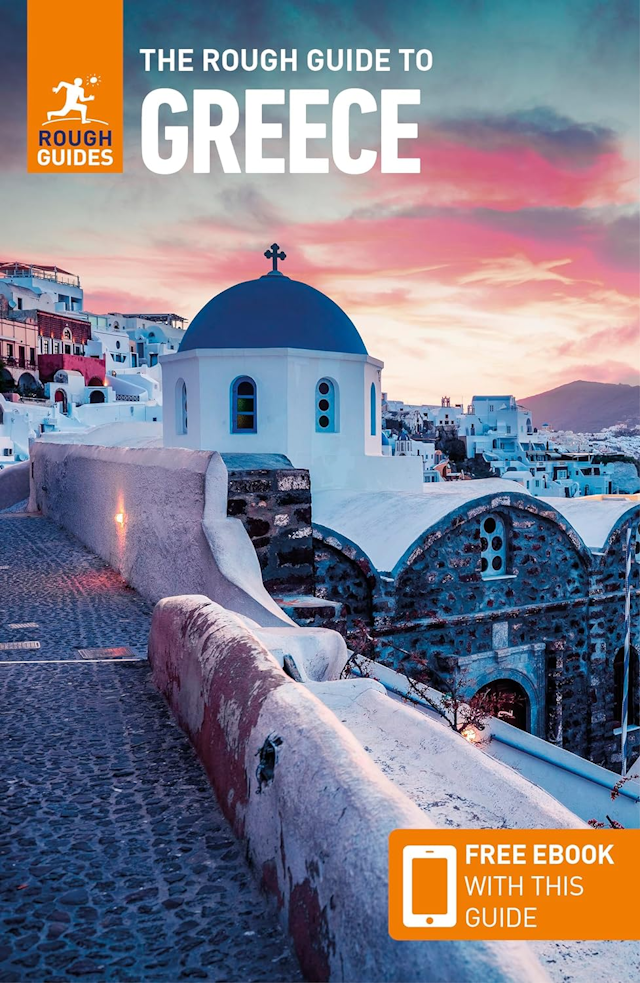- HOME
- Peloponnese
- Tiryns
Tiryns
The Greece Travel Secrets guide to the ancient archaeological site of Tiryns, near Mycenae, in the Peloponnese of Greece, a UNESCO World Heritage Site.
Where is Tiryns?
Tiryns is about 20 kms (12 miles) south of Mycenae, and 5 kms (3.1 miles) north of Nafplion in the Peloponnese of Greece. If you're based in Nafplion it's easy to combine visits to the two sites in one day, or if you're driving from Athens to Nafplion and make an early start you can also visit both sites on your journey.
Tiryns is about a 90-minute drive from Athens, or about two hours from Athens International Airport. There is some accommodation near Tiryns but our advice would be to stay in Nafplion and make the 5-minute drive to Tiryns.
 Map (c) Google Maps
Map (c) Google MapsWhy Is Tiryns Famous?
The site is mainly famous for its impressive fortifications, which date back to the Bronze Age, and for being one of the main centers of the Mycenaean civilisation.
How Old is Tiryns?
The earliest evidence of settlement in Tiryns dates back to the Neolithic period, around 4000 BC. However, it was during the Bronze Age that the site became an important center of Mycenaean culture, which flourished in Greece between 1600 and 1100 BC.
Mycenean Civilisation
The Mycenaean civilisation is known for its monumental architecture, including large palaces, tombs, and fortifications. Tiryns is particularly famous for its fortifications, which were built in several phases between the 15th and the 13th centuries BC. The walls of Tiryns are among the most impressive and well-preserved examples of Mycenaean military architecture.
Tiryns Fortifications
The first fortifications at Tiryns were built around 1500 BC, during the Middle Helladic period. These walls were made of stone and mud-brick, and they encircled the hill on which the palace and other buildings were located. However, these walls were not very strong and were replaced by new, more massive walls around 1400 BC.
The Walls of Tiryns
The new walls were built of huge limestone blocks, some of which weigh over 10 tons. These blocks were carefully fitted together without mortar, using a technique called "Cyclopean masonry," which is named after the mythical race of giants who were said to have built the walls. The walls were up to 7 meters (23 feet) thick and over 10 meters (33 feet) high, with towers and bastions at strategic points.
The construction of such massive walls required a large workforce and a high degree of organization. It's believed that the Mycenaean rulers of Tiryns controlled a large territory and had access to a substantial labor force, including slaves and prisoners of war.
The Palace of Tiryns
The Palace of Tiryns was located within the walls and was the residence of the Mycenaean rulers. The palace was a complex of buildings, including a central hall, private rooms, and storage areas. The central hall was the most impressive part of the palace and was used for public ceremonies, feasts, and other important events. The hall had a large hearth in the center and was decorated with frescoes and other artworks.
Tiryns was an important center of Mycenaean culture and played a role in the wider Mediterranean world. The Mycenaeans were skilled traders and sailors and maintained contacts with other civilisations, such as the Minoans on the island of Crete and the Egyptians.
Tiryns was also involved in the Trojan War, which is described in Homer's Iliad. According to the legend, the Mycenaean king Agamemnon gathered a large army at Tiryns and sailed to Troy to recover his wife, who had been kidnapped by the Trojan prince Paris.
Rediscovery of Tiryns
In the centuries that followed, Tiryns declined in importance and was eventually abandoned. The site was rediscovered in the 19th century by German archaeologist Heinrich Schliemann, who also excavated the nearby site of Mycenae. It's now a UNESCO World Heritage Site.
Latest Posts
-
Study: Athens Among Best Cities for Family Science Trips
Athens is ranked as one of the top European cities for family science trips, according to a report by Ubuy, a global e-commerce platform. Ubuy’s new report reveals Europe’s top 20 cities where familie… -
May 1: Greece Labor Day Strikes to Halt Public Transport, Ferries
Transportation and travel in Greece will be disrupted on Wednesday, May 1, as public transport and ferry employees have announced their participation in strike mobilizations to mark May Day. According… -
Technopolis: New 3-day Beer Festival Coming to Athens in May
A new beer festival is coming to Athens and for three days will quench the thirst of beer lovers with well-known and rare labels from around the world as well as from Greek microbreweries. Lager? Pils… -
5 Reasons to Spend Easter in Meteora
Renowned for its spectacular “hanging” monasteries and reverent atmosphere, Meteora is the perfect place to spend Greek Easter. -
3 Must-Visit Islands for Greek Easter
Boasting spectacular landscapes and unique local traditions, the islands of Lesvos, Ikaria and Andros are ideal vacation destinations for Greek Easter. -
Easter Cookies from Smyrna, a 100-Year-Old Recipe
Discover the secret to making the most delicious Easter koulourakia (cookies) from Smyrna, passed down through five generations. -
Greece Launches Contactless ‘Tap & Pay’ System on Athens Airport Express Buses
The Greek Transport Ministry on Wednesday launched a pilot ‘Tap & Pay’ contactless payment system for passengers traveling on the express bus lines in Athens that connect to Athens International Airpo… -
Acropolis Museum Exhibition: The Parthenon and Byron
On the occasion of 200 years since Lord Byron’s death, the Acropolis Museum in Athens is honoring his memory with a symbolic exhibition related to Lord Elgin’s taking of the Parthenon sculptures. -
Greece Bans Sunbeds, Umbrellas, Bars on 198 Beaches
Sunbeds, umbrellas, and all sorts of constructions have been banned on 198 beaches across Greece according to a joint ministerial decision signed this week by Economy & Finance Minister Kostis Hatzida… -
4 Guesthouses in Zagori that Are Worth Visiting
Amidst the mountains and spectacular scenery, these four traditional guesthouses in the heart of Zagori, Epirus, offer the very best in Greek hospitality.
























